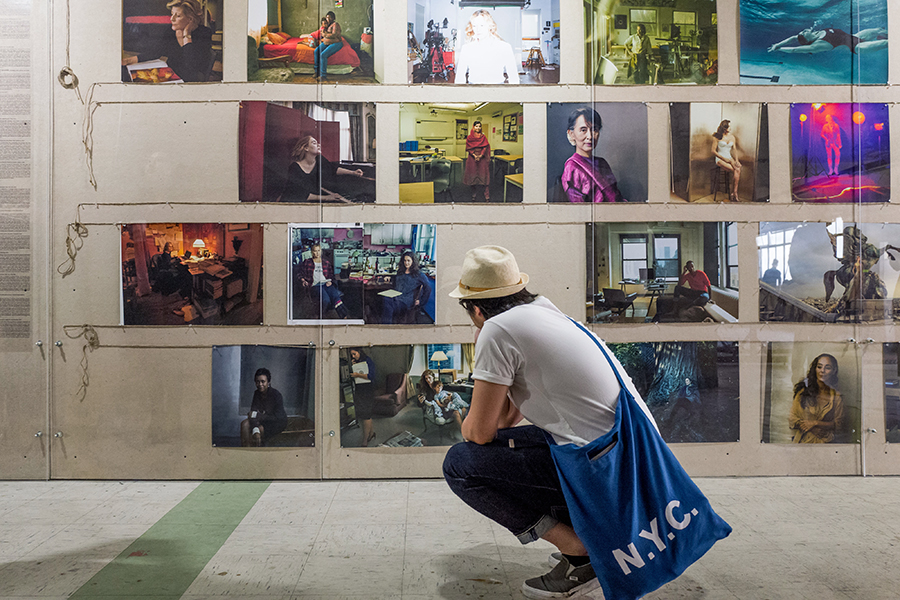Shows
Annie Leibovitz’s "Women: New Portraits"


When first approached to undertake “Women,” a 1999 publication and exhibition of photographs documenting female figures around the world, American photographer Annie Leibovitz’s first instinct was to decline. Such a task, she felt, would be the equivalent of “photographing the ocean.” Yet as she reluctantly began to take photographs for the series, collaborating with longtime friend and American feminist scholar Susan Sontag, Leibovitz found herself delightfully surprised by the range of portraits she accumulated and the boundless possibilities of shooting such a diverse subject matter.
Featuring more than 200 portraits of women from all walks of life—from coal miners and athletes to showgirls and movie stars—“Women” quickly became a success in the form of a bestselling publication and acclaimed exhibition at Washington, D.C.’s Corcoran Gallery.
Sixteen years later, Leibovitz has picked up where the she left off, with a new UBS-commissioned series of photographs expanding on the original, this time working with American feminist icon and author Gloria Steinem. “Women: New Portraits,” a 10-city touring exhibition that has shown in New York, London and Mexico City, made its fifth stop in the rugged confines of the Cheung Hing Industrial Warehouse in Kennedy Town, Hong Kong.
Chosen for its lack of gallery affiliations, the exhibition space is loosely divided into three sections. First is a library showcasing Leibovitz’s diverse body of work. One heavy volume, a limited edition compendium of the renowned photographer’s iconic photographs for Vanity Fair magazine, lay open to a picture of comedian Tina Fey dressed in a patriotic American costume, smiling while tipping a top hat and her nation’s flag. The photograph, a satiric nod to Fey’s famous impersonation of American right-wing politician Sarah Palin, was originally shot for the cover of Vanity Fair, for which Leibovitz began working in 1983. It exemplifies her signature style of combining soft lighting with bold colors. Next, in the central section of the space, three large screens present slideshows of photographs from the "Women" project since its inception. Finally, beyond the panels, tacked to a wall behind a glass screen, are the new portraits.

Steinem, who assisted Leibovitz in compiling a list of women to photograph for the updated series, herself appears in a portrait. A lamp casts a dim light on the clutter of papers and books strewn across her workspace, from which Steinem appears to take a brief break, as she turns slightly from her desk towards the camera. Another portrait, taken in 2015, features Pakistani activist Malala Yousafzai. Yousafzai’s fight for girls’ education in Swat Valley, a Taliban-controlled region of northwest Pakistan, led her to become the youngest ever recipient of the Nobel Peace Prize at age 17. In Leibovitz’s portrait, Yousafzai, now in self-exile, stands calmly under the flourescent lights of her new classroom and adopted home in Birmingham, England.
A portrait of American ballet dancer Misty Copeland reminds viewers of Leibovitz’s experience in fashion photography working for magazines such as Vogue. Copeland is the first African-American woman to be promoted to principle dancer in the American Ballet Theatre company’s 75-year history. Her rise to dancing stardom was a path filled with obstacles as she traversed the competitive, white-dominated world of ballet. Under Leibovitz’s lens, Copeland’s graceful dancer physique is hugged by a flowing cotton dress as she leans on pointed toes towards a breeze. Shot in a muted palette, the image is stripped of the traditional pastel colors and ruffled tulle typically associated with the centuries-old dance form. Instead, Leibovitz captures the sensuous elements of ballet through Copeland’s flowing hair and pleated dress.
Elsewhere, American artist Cindy Sherman’s downturned gaze captures attention in a portrait taken in her New York studio. Eyes averted, Sherman’s face is stark white from the overexposure of light bouncing off the white shirt she wears. The portrait reveals a disarming vulnerability that is in contrast to the direct gazes and deliberate poses viewers are accustomed to seeing in Sherman’s well-known performance-photos of the 1970s and '80s, in which she assumes the identity of various Hollywood female archetypes.
Many of Leibovitz’s famous subjects have faced adversity as women in the public eye. Facebook chief operating officer Sheryl Sandberg’s salary is frequently the subject of scrutiny when she is discussed in the media—a topic that rarely affords a second glance when concerning her male peers. In her portrait, Sandberg sits cross-legged in the company’s Silicon Valley headquarters, confronting the lens with a natural confidence and ease.
Also featured is the now-iconic portrait that marked the international debut of transgender celebrity Caitlyn Jenner in Vanity Fair last year. Some argued that Jenner’s portrait, in which she appears in a silk bustier, further played into Hollywood stereotypes of beauty. This particular argument, however, pointed to a larger, often misunderstood aesthetic of transgender females where—especially for those living in lower socio-economic communities—conventions of femininity are not only a natural expression of identity, but also a form of survival in a society that still recognizes gender identity in binary terms of male and female.

“Women: New Portraits” is described as a work-in-progress, yet at times the layout contradicted to this notion. The three large screens of olderworks from the series overshadowed the new printed photographs, while the room of publications served to showcase Leibovitz’s rich archive rather than celebrating her latest work. A pared-back approach would have supported a more coherent narrative in line with the exhibition’s aim to chronicle the changing role of women, and further allow the beautiful portraits and their stories to speak for themselves. What is clear, however, is Leibovitz’s ability to capture the essence of her subjects in images that become ingrained in public memory. Looking at her portraits of outstanding women making waves today, one can already imagine them becoming emblems of the shifting roles of women in the future.
Annie Leibovitz's "Women: New Portraits" is on view at Cheung Hing Industrial Building, Hong Kong, until June 26, 2016.







